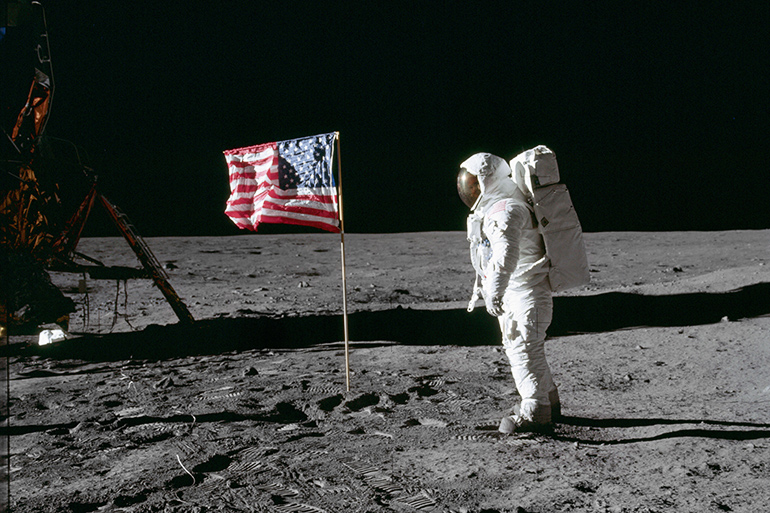Remembering the Moon Landing 50 Years Later

Everyone knows at least a little something about the first Moon landing—when American astronauts Neil Armstrong and Edwin “Buzz” Aldrin made that small step for man and giant leap for mankind on July 20, 1969—but few know of Long Island’s vital role in this significant historic event.
On Saturday, July 20 at 1 p.m., five decades after NASA made their landmark achievement, Montauk Observatory is hosting a 50th anniversary celebration of Apollo 11 at Stony Brook Southampton’s Avram Theater (239 Montauk Highway), including a special panel featuring former Grumman employees who helped build the Lunar Excursion Module (LEM) right here on Long Island and get it safely to the Moon’s surface.

Along with the Grumman roundtable discussion, this five-hour event will feature expert talks and a screening of Todd Miller’s vaunted documentary film Apollo 11, including never-before-seen footage and audio recordings from NASA’s breakthrough mission with Armstrong, Aldrin and Michael Collins making the journey that captured the imaginations of people around the world and, for many, inspired a lifelong love of astronomy and space exploration.
“I just remember watching the footage,” Montauk Observatory Executive Director Donna McCormick says, recalling her experience watching the Moon landing at around age 14. “Everybody was so pumped up about what was happening, and so was I,” she adds, pointing out that she hasn’t stopped looking to the stars since. “I’ve always been the kind of person who believes anything is possible.”

Another program regular, retired physics teacher and NASA Solar System Ambassador Paul Stengel was 26 years old at the time. “It was a little bit surreal,” Stengel says, remembering sitting in his family’s living room, watching the event on a black and white TV with his parents. “This sentence was flashing on the bottom of the screen: ‘Live from the Moon.’”
NASA was only created in 1958, 11 years before Apollo 11’s mission, and President John F. Kennedy had just announced America’s goal to walk on the Moon in May of 1961, Stengel points out, adding, “The paint wasn’t even dry on the [NASA] logo.” And now it was happening. “This was the greatest technological achievement of the 20th century,” he says.

Montauk Observatory President Terry Bienstock, who was 15 in July of ’69, also clearly recalls that momentous day. “It was a miracle. There are a few events in your life where you remember where you were when it happened,” Bienstock says. “I remember sitting in my den with my family and watching it, and being extraordinarily moved,” he adds, noting that he loved science fiction and monster movies as a kid growing up in the 1950s and ’60s. “It was a fantasy. I get emotional about it now.”
Later in life, when he was a senior executive for Comcast, Bienstock had the pleasure of meeting Armstrong in Los Angeles. “He was just the nicest, most unassuming gentleman,” Bienstock says, explaining how learning his hero was just like anybody else, in many ways, inspired him even more. “It just showed what ordinary people can do…sometimes by talent, sometimes by fortune.”

Bienstock also points out that the Moon landing succeeded in a time when technology was so far removed from what NASA has today. “Think of doing all this with no computers—it’s staggering,” he says. “It’s amazing what they were able to accomplish…a cellphone has more computing power than the whole mission combined.”
Among the former Grumman employees offering a behind-the-scenes view of what went on while building the Lunar Module at the company’s Bethpage location, roundtable moderator Raymond LeCann processed critical data during testing and construction of the LEM to ensure it was flightworthy. “It was a wonderful experience for all of us,” he says, proudly looking back at those difficult years of long hours and time away from family. “The Grumman team really worked very hard on this program,” LeCann, who was 35 in 1969, recalls, noting that his team was nervous at times, but “always self-assured we were going to be successful.”

And, as a result, he says they did something important for the world. “I hope that we learned that our planet is vulnerable,” LeCann adds, referring to the famous “blue marble” image which showed Earth from a new perspective. Unfortunately, he says, Grumman paid a price for the project—especially as government interest and funding for space exploration waned in the years following their great accomplishment.
NY State Assemblyman Fred Thiele will introduce the Grumman roundtable panelists on Saturday and present each with a NY State citation acknowledging their contributions to the Apollo 11 mission. Thiele was almost 16 years old when he watched the Moon landing. “It’s one of those dates that you remember everything about,” he says. “We watched every launch of Mercury and every launch of Gemini right in the classroom—it was a big deal,” Thiele adds, recalling the Space Race era. “It was such a monumental achievement.”

Other events at Saturday’s celebration include a “50 Years of Lunar Science” lecture by Stony Brook professor Timothy Glotch; a Q&A with film production team manager and NASA Spaceflight Data Manager & Researcher Ben Feist; and more.
Visit montaukobservatory.com for a complete schedule and program details.



